PRINCETON, NJ -- After the release of her much-publicized autobiography and the ensuing book tour, Sarah Palin is still viewed more unfavorably than favorably by Americans, though her favorable rating has improved slightly (now 44%, up from 40% in October).
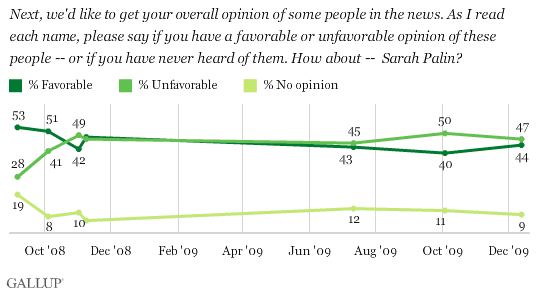
While releasing a best-selling autobiography may have had a modest positive effect on views of her, it did not register quite the same impact as former first lady Hillary Clinton's book release appeared to in June 2003. Prior to the publication of Clinton's memoir "Living History," 45% of Americans viewed her favorably and 46% unfavorably. Those ratings shifted to 53% favorable/43% unfavorable when the book was released, and remained above 50% for the next three-plus years.
Like Clinton, the former Alaska governor and 2008 Republican vice presidential candidate is a politically polarizing figure. Palin is viewed favorably by 79% of Republicans, 40% of independents, and 21% of Democrats. Since October, Palin's ratings are up among both Republicans and Democrats, but are essentially flat among independents.
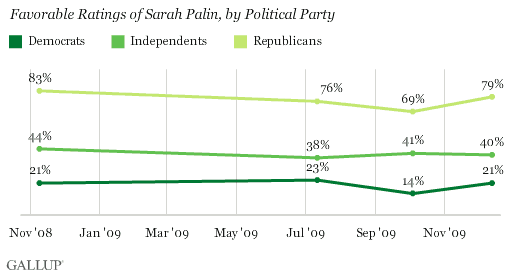
Palin's future plans remain a topic of much speculation, and include the possibility that she will seek the GOP presidential nomination and challenge Barack Obama for president in 2012. At this point, Obama is the more popular of the two. The Dec. 11-13 USA Today/Gallup poll finds 56% of Americans saying they have a favorable view of the president, with 42% viewing him unfavorably.
Obama's favorable rating has been steady since October, but remains down significantly from earlier this year. And his favorables continue to exceed the 50% mark even as his approval ratings have been below that level for much of the past several weeks.

The pattern of higher favorable ratings than approval ratings has been typical for presidents since 1993, when Gallup regularly began tracking both measures. The two measures generally move together, with the favorable rating the higher of the two. That has been the case for Obama to date.

The same pattern applied to George W. Bush -- aside from two measurements shortly after 9/11, when his approval rating matched his favorable rating. Throughout his presidency, Bush's favorable rating exceeded his approval rating by an average of five points.
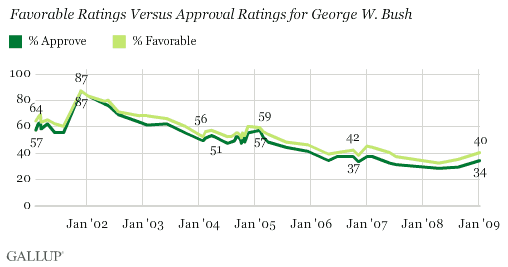
The notable exception to the general historical pattern of higher favorable than approval ratings occurred in the latter part of Bill Clinton's presidency, after the Monica Lewinsky scandal broke. Prior to late January 1998, Clinton's favorable ratings exceeded his approval ratings by an average of six points. From then until the end of his presidency, however, Clinton's approval ratings were eight points higher than his favorable ratings, on average.
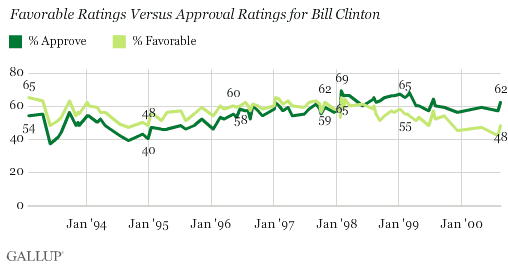
Currently, Obama is viewed positively by 91% of Democrats, 53% of independents, and 19% of Republicans. All three party groups give him slightly lower marks for the job he is doing as president.
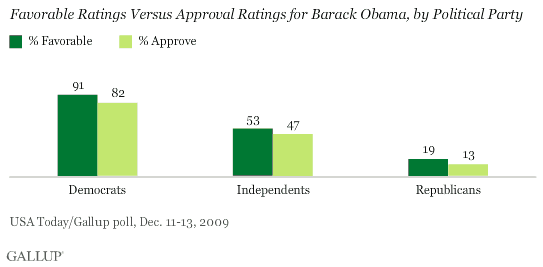
Over the course of the year, Obama's favorable rating has fallen sharply among Republicans, from 60% just before he took office to 19% in the current poll. Independents' ratings of Obama have also declined significantly, though to a smaller degree than Republicans'. Most of the decline in independents' favorable ratings of Obama occurred between July and October. Democrats' ratings have remained strong throughout the year, generally in the 90% range.
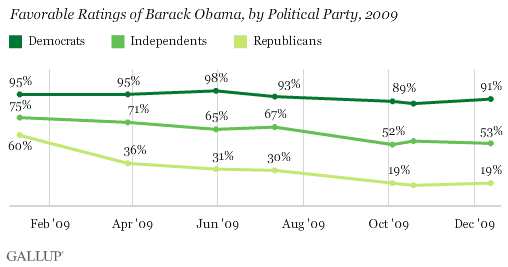
These changes generally mirror the trends in Obama's approval rating by party.
Bottom Line
Obama and Palin are arguably the most prominent members of the Democratic and Republican Parties at the moment. While Obama's popularity has sagged over the course of the year, he remains a more popular figure than Palin, and continues to receive higher favorable ratings than overall job approval ratings. Palin's recent book release and the surrounding publicity seemed to have a very modest effect on how Americans view her, but on balance the public still views her more negatively than positively.
Survey Methods
Results are based on telephone interviews with 1,025 national adults, aged 18 and older, conducted Dec. 11-13, 2009. For results based on the total sample of national adults, one can say with 95% confidence that the maximum margin of sampling error is ±4 percentage points.
Interviews are conducted with respondents on land-line telephones (for respondents with a land-line telephone) and cellular phones (for respondents who are cell-phone only).
In addition to sampling error, question wording and practical difficulties in conducting surveys can introduce error or bias into the findings of public opinion polls.
